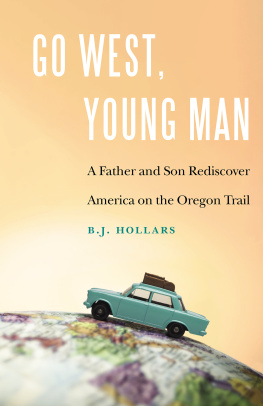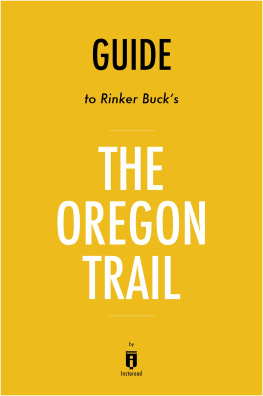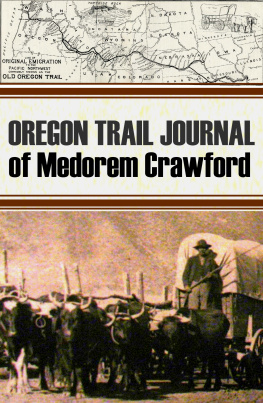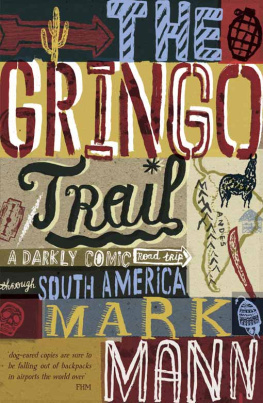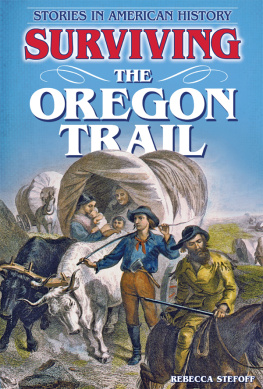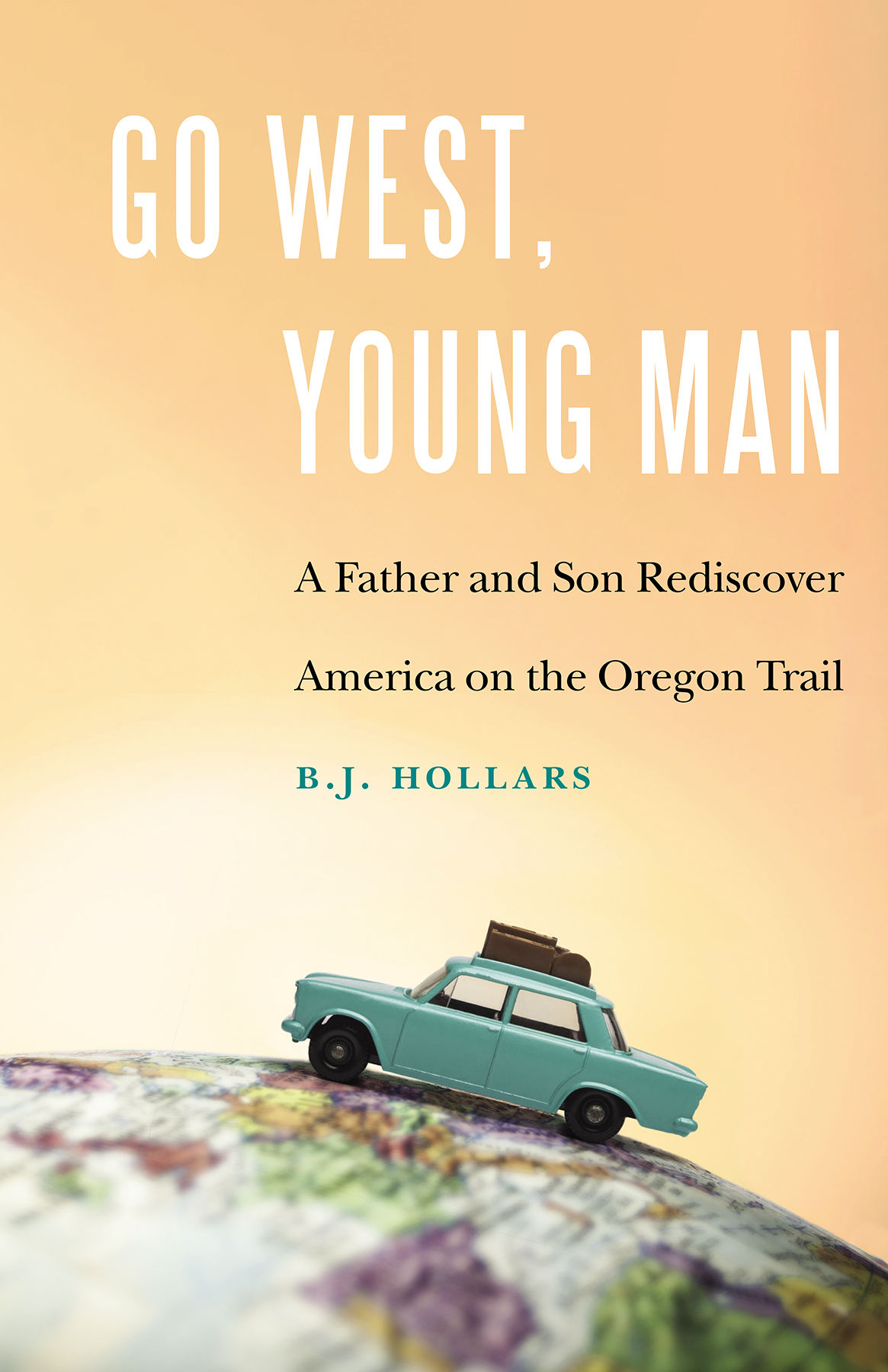
The Oregon Trail was once firmly woven into Americas idea of itself due in part to chroniclers like Francis Parkman, who lit out in 1846 with horse and mule cart on a tour of curiosity and amusement. More than a century and a half later, B.J. Hollars and his six-year-old son embark in a rented vehicle along the same westward route and with the same intention. In this mock adventure, father and son endure prairie swales and cyclonic winds, KOA s and interpretive centers, and self-inflicted dad jokesall to answer this countrys most enduring question: Who are we?
John Hildebrand, author of Long Way Round: Through the Heartland by River
Hollars resists easy ideas and easy answers, but the insights that he does reach are presented effectively and compellingly.... Go West, Young Man asks big questions about the multiplicity of American identities and narratives, and offers us a view toward how a father and son can answer them.
Colin Rafferty, author of Execute the Office and Hallow This Ground

Go West, Young Man
A Father and Son Rediscover America on the Oregon Trail
B.J. Hollars
University of Nebraska Press | Lincoln
2021 by B.J. Hollars
Cover designed by University of Nebraska Press; cover image: iStock / michaelquirk.
Author photo courtesy of the author.
All rights reserved
Library of Congress Cataloging-in-Publication Data
Names: Hollars, B. J., author.
Title: Go west, young man: a father and son rediscover America on the Oregon Trail / B.J. Hollars.
Other titles: Father and son rediscover America on the Oregon Trail
Description: Lincoln: University of Nebraska Press, [2021] | Includes bibliographical references.
Identifiers: LCCN 2020054617
ISBN 9781496228420 (epub)
ISBN 9781496225900 (paperback)
ISBN 9781496228437 (pdf)
Subjects: LCSH : Hollars, B. J.TravelOregon National Historic Trail. | Hollars, B. J.Family. | Hollars, HenryTravelOregon National Historic Trail. | Oregon National Historic TrailHistory. | Northwestern StatesDescription and travel. | Automobile travelNorthwestern States. | Fathers and sonsNorthwestern States. | Fathers and sonsOregon National Historic Trail.
Classification: LCC F 597 . H 73 2021 | DDC 978dc23
LC record available at https://lccn.loc.gov/2020054617
The publisher does not have any control over and does not assume any responsibility for author or third-party websites or their content.
For travelers
past, present, and future.
And for Henry
wonderer, wanderer, and big-hearted boy.
Look out at the meadow, you can almost see them,
generations dissolved in the bluegrass and hay.
I want to try and be terrific. Even for an hour.
from Ada Limns During the Impossible Age of Everyone
Contents
Writing this book required a wagon trains worth of support. Thanks to every person we met along the trail, most notably John Bevis, Travis Boley, Randy Brown, Rachel Burr, Roger Castle, Barbara Clark, Mary Cone, Steve Fullmer, Ralph Goldsmith, Gene Hunt, Duane Iles, Ellie Isenhart, John Jarvie, Liz Nakazawa, Karen Nelson, Vance Nelson, Loren Pospisil, Becky Smith, Kale Wuthrich, and Shawneen Wuthrich. Your powerful insights on the past and present allowed this book to be.
Thanks, as always, to my inspiring students. How to thank you for allowing me to live starry-eyed within this book for years?
To my colleagues and friends at the University of WisconsinEau Claire: Dr. Debra Barker, Brett Beach, Chair Erica Benson, Nick Butler, Dr. Dorothy Chan, Dr. Jeff DeGrave, Joanne Erickson, Dean Rodd Freitag, Max Garland, John Hildebrand, Provost Patricia Kleine, Greg Kocken, Allyson Loomis, Jon Loomis, Dean Carmen Manning, Dr. Justin Patchin, Molly Patterson, Chancellor Jim Schmidt, Kim Pickering Schmidt, Patti See, Dr. Asha Sen, Dr. Jason Spraitz, Chair Jan Stirm, Bruce Taylor, Dr. Paul Thomas, and President Kimera Way.
Thanks to Dr. Karen Havholm and the Office of Research and Sponsored Programs at the University of WisconsinEau Claire, whose travel support proved vital to this project. Thanks, too, for the support provided by the University of WisconsinEau Claire Academic Affairs Professional Development Program.
To the Eau Claire writing community and, in particular, early reader Jim Alf. But also, Tom Giffey, Kyran Hamill, Rebecca Mennecke, Nick Meyer, and Mike Paulus. And to the well-wishers too: Mike Felton, Matt Larson, Todd Leavitt, Jim McDougall, Josh Miller, and oh so many more.
Thank you to the Wait! What? Writers and to Eric Rasmussen, in particular.
To Sarah Johnson and Serena Wagner of Odd Brand Strategy for the mapmaking and for creating a better world.
To the University of Nebraska Press family, and especially to my eagle-eyed copyeditor, Elizabeth Gratch.
And finally, to my familylooking forward to the journey ahead.
While writing a book about the Oregon Trail isnt nearly as difficult as crossing it, indeed, it has its challenges. Part of the trouble is that the trails a mirage of sortssimultaneously there but not there, viewable but only when you know where to look. To a great extent this book was written thanks to the people who showed me where to direct my eyes, dozens of interviews conducted both on scene and in person. In a few instances I interviewed people on several occasions, then, for readability purposes, incorporated their comments into a single scene. Its worth noting that my number one interviewee wasnt an interviewee at all but my son and sidekick, then-six-year-old Henry. While I like to think our banter is always as delightful as depicted herein, Ill admit that on a few occasions, by way of language selection, I claimed fatherly privilege and amped up our delightfulness just a smidgen.
My primary sources came in many forms, though mainly trail journals. Theres no better way to get inside the hearts and minds of nineteenth-century overland emigrants than by reading their own accounts. Thankfully, several online repositoriesincluding the Oregon-California Trails Associations collectionsprovide a wealth of trail journals available to the public.
For a complete list of sources, I refer you to the bibliography at the end of this book. For now Ill offer thanks to the authors and historians whom I relied upon most frequently, those who became fellow travelers in my own personal wagon train: Merrill Mattes, Irene Paden, John Unruh, Gregory Franzwa, Dee Brown, Roxanne Dunbar-Ortiz, and Rinker Buck. I wouldnt have made it a mile without you.
This book would not have been possible without the work of those whove come before. In many instances I employed direct quotations from trail journals and historical scholarship to bolster and support my own work. For readability purposes I often refer to individuals and historians broadly rather than credit them by name within the text itself. Make no mistake: these individuals deserve full credit for their words; citations are available in the notes section of this book.
When writing of Americas first inhabitants, I have taken a cue from similar books by using the phrases Native American as well as indigenous people. In a few quotations the phrase American Indian is also employed. Additionally, every effort was made to reference specific tribal nations when appropriate and verifiable.
Its important to note tooas I do in chapter 4that I am far from the ideal conveyer of the many Native American portions of this story. White writers such as me need to do a far better job of elevating, centering, and amplifying indigenous voices rather than try to tell this history ourselves. Though my efforts in this regard remain wholly insufficient, I have tried to rely upon Native American voices, both past and present, to offer a more complete and more accurate portrayal of this story. A visit to Tamstslikt Cultural Institute in Pendleton, Oregonwhich provides a tribal perspective of western expansionismfundamentally altered my understanding of this history. Please visit if you can.

